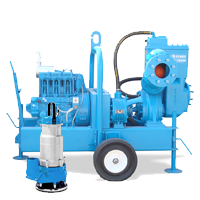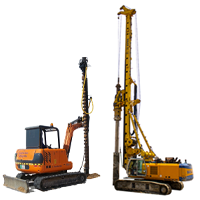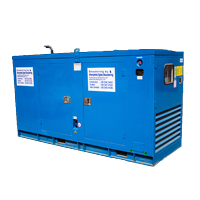Wellpoint Dewatering
Wellpoint dewatering systems enable the groundwater table to be lowered for deep and large construction sites in high permeable soils. It is a proven and very flexible system within this environment. The water is pumped from wellpoints, installed along the perimeter of the site. The wellpoints are jetted in and spaced to obtain the optimal draw-down against lowest capacity. The wellpoints with integral strainers are then joined to transparent flexible hoses, which are connected by quick release couplers to the ring main header pipe.
Wellpoint Dewatering Systems
Since its conception in the 1920s, the wellpoint system has not conceptually changed and is the oldest practical method of dewatering. The basic components are a wellpoint pump, which is connected to header pipes, which are then connected to the wellpoints themselves.
The intake end of the Sykes wellpoint pump is linked to a level header manifold, which runs alongside the excavation. The header pipe distributes the vacuum to a series of individual wellpoints and transfers the water lifted from these wellpoints to the Sykes pump. Wellpoints are long thin tubes, generally small in diameter, constructed with a screen intake and usually a surrounded by a filter pack, drawing the water from the ground by the suction generated by the pump.
A wellpoint dewatering system can consist of several wellpoints, or hundreds of well points, connected to a network of Sykes high vacuum priming pumps. This is a popular solution within the construction and dewatering industry.
Typically, wellpoints are installed around the perimeter of an excavation. They can also be installed within an excavation for deeper work or outside the excavation if excavation is relatively shallow.
Depending on the type of excavation and project requirement, different methods of wellpoint dewatering systems can be used. All these systems are based on the same principle of using multiple wellpoints joined into a common header pipe, but the type of installations is varied to meet the demands of the project.
Wellpoint Dewatering Closed Ring Installation
Where bulk excavation is required, the most frequently employed method of Wellpoint dewatering involves the enclosure of the excavation area by a ring of header pipe with Wellpoints placed at predetermined intervals. Excavations to a depth of 5m can be effectively dewatered by a single ring of Wellpoints. Where the water table is to be lowered to a deeper level, a multiple-stage Wellpoint system is employed.
Following achievement of the initial drawdown, the ground is excavated to the limits of the first stage and a second installation is set at this new level. It is possible to introduce a number of further stages in this manner, although in the case of very deep excavations, the possibility of adopting a combination of drainage systems should be considered.
Wellpoint Dewatering Progressive Line Installation
Designed for pipelines and other similar applications, a progressive or roll along dewatering approach is installed alongside the route, preceding excavation and pipe laying. Equipment from a previously completed and backfilled section is installed at the head of the line, removing the need for large quantities of equipment.
Wellpointing systems are used principally to lower groundwater levels around foundations ensuring stable working conditions are maintained. A closely spaced series of small-diameter shallow tubes (or wells) are connected to a common header pipe where a partial-vacuum is created. One Sykes high-efficiency vacuum dewatering pump can operate 100m length of wellpoints. For draw-downs greater than 6m, further stages of wellpoints are often installed at lower levels as the excavation progresses.
Wellpointing is particularly effective for moderate draw-down duties across a wide range of ground types from gravel through to fine sand, as is often found in the Middle East. Drilling installation may be required in coarse or hard soils, but for much of the sandy environments in the Middle East, a more rapid and cost-effective wellpoint installation process is to jet in the well points using high-pressure water pump. Jetting also encourages an improved hydraulic connection and allows the setup of a granular filter pack to enhance performance in stratified fine soils.
Open Dewatering
Open dewatering systems enable one to lower groundwater table adequately in cohesive and low permeable soils. Water is pumped off directly from sumps (ditches) along the toes of the slopes of the excavation works. The suction hose with strainer is merely placed in the sump and the collected water is primed and discharged. This makes the open dewatering system easy to install and simple to operate. The open dewatering system utilizes self-priming, or vacuum assisted centrifugal pumps; the Sykes GP range of pumps are ideally suited for this application.
Buried Installation
Where deeper excavation is required close to other buildings or in restricted areas a buried system can be considered. With this method the header pipe is buried below the ground level which in turn allows the wellpoints to be installed at greater depth and thereby provide dewatering to lower levels.
The wellpoint dewatering system utilizes self-priming, or vacuum assisted centrifugal pumps, and the Sykes WP & GP range of pumps are again perfectly adapted for this application within the Middle East.
Deep Well Dewatering
When the water table needs to be lowered below 6 metres, or when conventional vertical wellpointing in stages isn’t feasible, Andrews Sykes Hire Saudi can offer an economical Deep Well dewatering solution.
A hole is bored from the surface level to a depth below that of the final excavation. A specially designed well screen is then positioned into the hole and a submersible pump is then lowered into the well. Once the submersible pump has started, the groundwater is lowered.
The pumps that are used in deep well dewatering applications are often high efficiency, multistage, electro submersible units, with discharge heads of over 40 metres. This system can reduce groundwater levels for even the deepest of open excavations.






